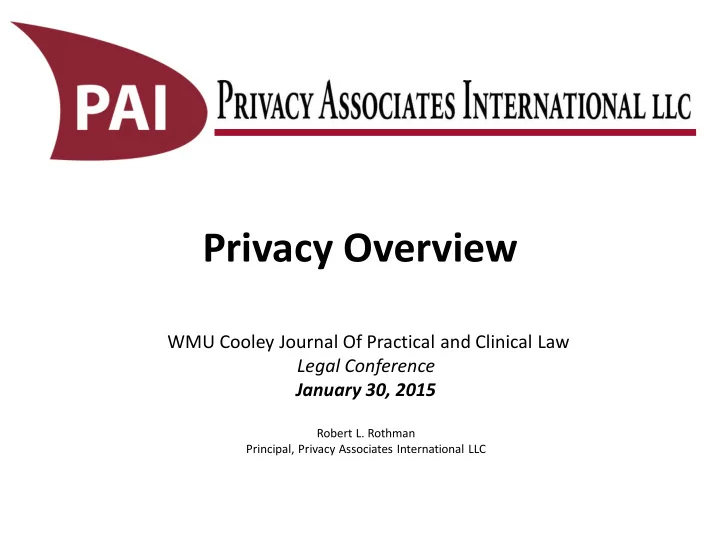

Privacy Overview WMU Cooley Journal Of Practical and Clinical Law Legal Conference January 30, 2015 Robert L. Rothman Principal, Privacy Associates International LLC
Purpose • What is Privacy? • Historical Development
What is privacy? 3 3
What is Privacy? • Different meanings to different people • Large element cultural • Hundreds of definitions
Privacy “Privacy is the claim of individuals, groups, or institutions to determine for themselves when, how, and to what extent information about them is communicated to others.” - Alan Westin 5 5
Privacy “Privacy is a mix of the following general ideas: (1) The right to be let alone — Samuel Warren and Louis Brandeis’s famous formulation for the right to privacy; (2) Limited access to the self — the ability to shield oneself from unwanted access by others; (3) Secrecy — the concealment of certain matters from others; (4) Control over personal information — the ability to exercise control over information about oneself; (5) Personhood — the protection of one’s personality, individuality, and dignity; and (6) Intimacy — control over, or limited access to, one’s intimate relationships or aspects of life.” -Daniel Solove 6 6
Where Did Privacy Concerns Come From? Privacy concerns and legal responses to address those concerns have existed for LONG time
Adam & Eve
The Epic of Gilgamesh
Code of Hammurabi
Justices of the Peace Act, England 1361
American Privacy Has its roots in disruptive new technology
The “Yellow Press” • Gossip and hearsay articles pervasive • Provided publication to private facts • Particularly disturbing to “society” families • The Kodak camera exacerbating the situation
The Right to Privacy 4 Harv. L. Rev. 193 (1890) Samuel Warren Louis Brandeis
The Right to Privacy • Authors were seeking to find a legal remedy in the common law for the perceived problem – No federal constitutional right to privacy – No applicable statutory provisions • Pointed out that the law had long recognized physical rights and injuries but was beginning to mental rights and injuries as well – Intellectual property vs. physical property – Assault (threat of harm) vs. Battery • Asserted privacy invasion a mental injury which should be protected as part of the “natural evolution toward civilized life”
“The Right To Be Let Alone” • Authors pointed to other protections the common law provides for: – The right to determine the extent to which our thoughts are communicated to others – The protection of letters, diaries, etchings and art – The protection of a catalogue of one’s etchings – The right not to be assaulted or beaten – The right not to be imprisoned – The right not to be maliciously prosecuted – The right not to be defamed • Authors then argued that all of these rights derive from a more general common law principle: the right to be let alone, now one of the most well-recognized phrases in American privacy law • Where did Warren & Brandeis get the phrase?
A Treatise on the Law of Torts or the Wrongs Which Arise Independently of Contract (1878) Thomas M. Cooley
Privacy Not an Absolute Right • Warren & Brandeis recognized privacy not an absolute right • Issues with First Amendment free speech rights • Issues with Fourth Amendment search and seizure rights • For instance: – Can an ex-lover write a tell-all biography revealing intimate details about your physical relationship? – Is a statute prohibiting a newspaper from publishing the name of a child rape victim constitutional? – Can the police use thermal imaging on your home or a GPS tracker on your vehicle without a warrant?
Prosser’s Torts • Identified (in 1960) four distinct torts that developed since the 1890 Warren & Brandeis article – Intrusion upon the plaintiff’s seclusion or solitude, or into his private affairs – Public disclosure of embarrassing private facts about plaintiff – Publicity which places the plaintiff in a false light – Appropriation, for the defendant’s advantage, of the plaintiff’s name or likeness • Collectively known as Invasion of Privacy • Adopted by the Restatement of Torts
1977 Organisation for Economic Co-operation and Development (OECD) Guidelines • An influential international economic organization of 34 countries founded in 1961 to stimulate economic progress and world trade • Developed privacy guidelines that have become the fundamental basis for information privacy laws
The Eight OECD Guidelines 1. Collection Limitation 2. Data Quality 3. Purpose Specification 4. Use Limitation 5. Security Safeguards 6. Openness 7. Individual Participation 8. Accountability
Statutory Approach to Privacy • Most countries with privacy legislation have adapted the OECD Guidelines in omnibus privacy laws • U.S. has a sectoral approach to privacy legislation • As a result, we now have a hodge-podge of hundreds of federal and state privacy laws that deal with privacy in different contexts • Each statue is aimed at different problems and has different definitions of what constitutes personal information • Incomprehensible system for those outside the US (and many of us inside the US) 23
Conclusion • Privacy is a broad, complicated and increasingly critical area of the law • Even though privacy concerns may have started with Adam and Eve, the law in this area is still in its infancy • As technology continues to explode the law will have to struggle to keep up 25
Recommend
More recommend